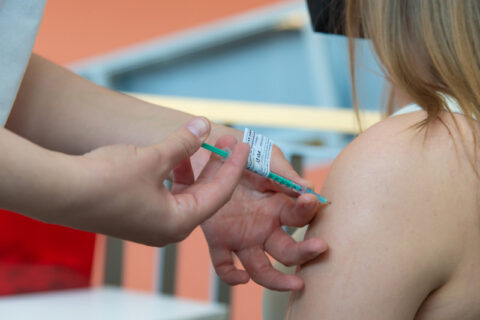FAU physicist investigating the inner structure of the Covid-19 vaccine
Since 2020, very many people across the globe have been vaccinated against Covid-19, but the exact structure of this vaccine has remained largely unknown until now. Prof. Dr. Tobias Unruh from the Chair of Crystallography at FAU and his team are now taking a closer look. The results of their complex analyses differ at times considerably from previous expectations. Active substances and pharmaceutical excipients incorporated in these mRNA vaccines appear not to be solid, as was previously suspected, but instead consist of numerous liquid nano droplets.
Liquid nanospheres
“The size and inner structure have a major impact on how the active substance is absorbed by the organism, how it is distributed and accordingly how it works and which side effects it causes,” explains Tobias Unruh. Knowing the structure of a medicine or vaccine like this helps optimize its effects and makes it easier to analyze possible side effects. In turn, this increases the possibilities for preventing or mitigating these side effects. Although it goes without saying that the chemical composition of the Covid-19 vaccines is known, investigating their structure in practice remains difficult.
This is due to the fact that modern active substances are often unstable in water or very poor at dissolving and can therefore only be introduced to the bloodstream with difficulty. Instead, such substances are often encapsulated in lipids. These often have a fatty structure on one side that is well suited for encapsulating such substances, while the other end dissolves well in water. These properties allow dispersions to be created, with the active substance contained within fatty droplets whose outer layer copes well in water. As such lipid droplets with a diameter of less than one thousandth of a millimeter are already at the nanometer scale in size, they are referred to as “lipid nanoparticles” or LNP for short.
As the structure of such dispersions and their effects in the human organism are highly complex and extremely difficult to pinpoint, until 2020 active substances encapsulated in LNP like this were only used for severe diseases such as cancer and therefore only given to a relatively small number of people. The situation changed dramatically with Covid-19 and the vaccines various companies developed against this infection.
These vaccines contain an entirely new active substance known as mRNA, included for example in the Comirnaty formulation distributed by the companies BioNTech and Pfizer. In biochemistry, mRNA refers to relatively small nucleic acids that are a copy of the genome and that therefore carry instructions for building certain proteins. In the case of the vaccine Comirnaty investigated by Tobias Unruh and his team, this mRNA contains all the information needed to create a protein that very closely resembles the spike protein protruding from the surface of the SARS-CoV-2 virus. This protein attaches to certain surface structures of cells in the human body, triggering the infection with the pathogen.
If the vaccine is injected into a person’s upper arm, some cells in the body ingest these mRNAs, and then begin to produce the spike protein in the person’s cells, following the instructions included in the mRNA. The organism’s immune cells identify this protein as a potentially dangerous intruder and set the body’s immune system into action. In this way, the body builds an immune reaction that allows the body’s immune system to get off to a flying start in the event of a later infection that can prove to be decisive for the health and survival of the affected person.
Until now, however, scientists have been unaware of the exact structure of the formulation despite its importance for the effectiveness and possible side effects of the vaccine. Tobias Unruh and his team have therefore carried out in-depth investigations using a wide range of modern analysis methods. The small group developed a method that can be used to combine the results of measurements using small-angle X-ray scattering and dynamic light scattering, both of which can be used to determine the size of LNPs. The results of these calculations were surprising: “It became apparent that the internal structure of the lipid nanoparticles in the Comirnaty vaccine is quite different from how BioNTech had previously expected,” says Tobias Unruh. The vast majority of the predominantly spherical lipid droplets with the active substance were only 55 nanometers in size, with one nanometer equivalent to one millionth of a millimeter.
Alongside these very uniform nano droplets, Unruh and his team discovered a few giants with a diameter of approximately 1000 nanometers, therefore approximately 20 times larger than most of the other spheres.
Unruh’s partner in the collaboration Frank Steiniger at Universitätsklinikum Jena has conducted a particularly spectacular test: A sample of the vaccine is shot into liquid ethane which at a temperature of minus 180 degrees Celsius is only 93 degrees above absolute zero. “The sample cools extremely quickly, at a rate of approximately one million degrees per second, and the water it contains does not even have time to form crystals,” explains Tobias Unruh. This solidified mass can then be analyzed using a transmission electron microscope. There, the tiny droplets are seen as disks whose diameter can be measured. This direct measurement gives the same results as the newly developed combination method, therefore confirming the results.
“Using the optical microscope, we were even able to see the very few giant droplets directly,” Tobias Unruh remembers. After several further measurements using Raman and nuclear magnetic resonance spectroscopes, the FAU group was finally able to determine that the internal lipid nanoparticles are liquid and not solid, as was apparently presumed during the approval procedure for the Comirnaty vaccine. Tobias Unruh and his team have therefore created an important basis for better understanding the effect and side effects of the Covid-19 mRNA vaccine.
Further information
https://doi.org/10.1021/acsnano.4c02610
Prof. Dr. Tobias Unruh
tobias.unruh@fau.de
